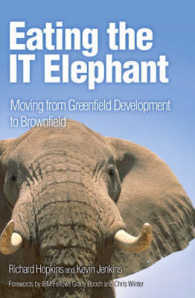- ホーム
- > 洋書
- > 英文書
- > Business / Economics
Full Description
This book provides a detailed insight into the simulation approaches employed in the study of supply chain management and control. It begins by examining the types of simulation models (continuous simulation, discrete-event systems and simulation games) before moving on to the distribution levels of systems and models. It concludes with a thorough discussion of simulation products. Simulation methodologies and techniques are also covered throughout the text and case studies are included to highlight the pivotal role played by simulation in the decision-making processes of those working in this field.
Contents
Chapter 1. Supply Chain Management SimulationTHIERRY, Gerard BEL and Andre THOMAS). 1.1. Supply chain management. 1.2. Supply chain management simulation. 1.3. Supply chain management simulation types. 1.4. Decision systems and simulation models (systems). 1.5. Simulation software. 1.6. Simulation methodology. 1.7. Conclusion. 1.8. Bibliography. Chapter 2. Continuous Simulation for SCM (Daniel THIEL and Vo Thi Le HOA). 2.1. System dynamics models for SCM. 2.2. Application: recent research into the bullwhip effect. 2.3. Conclusion. 2.4. Bibliography. 2.5. Appendix 1. Chapter 3. Discrete-event Simulation for Supply Chain Management (Valerie BOTTA-GENOULAZ, Jacques LAMOTHE, Florence PICARD, Fouad RIANE and Anthony VALLA). 3.1. Discrete-event simulation and supply chain. 3.2. Discrete-event simulation for supply chain redesign. 3.3. Discrete-event simulation for cooperation process risk analysis. 3.4. Discrete-event simulation for business process reengineering. 3.5. Conclusion. 3.6. Bibliography. Chapter 4. Simulation Games (Thierry MOYAUX, Eric BALLOT, Michel GREIF and Bertrand SIMON). 4.1. Introduction. 4.2. Literature review. 4.3. Theories about the usage of games. 4.4. Examples of implementation methodologies and obtained results. 4.5. Conclusion. 4.6. Bibliography. Chapter 5. Centralized Approaches for Supply Chain Simulation: Issues and Applications (Lyes BENYOUCEF, Vipul JAIN and Patrick CHARPENTIER). 5.1. Introduction. 5.2. Supply chain centralized simulation a literature review. 5.3. Supply chain simulation using centralized approaches. 5.4. Some industrial and practical applications. 5.5. Conclusions and perspectives. 5.6. Bibliography. Chapter 6. The Interest of Agents for Supply Chain Simulation (Thibaud MONTEIRO, Didier ANCIAUX, Bernard ESPINASSE, Alain FERRARINI, Olivier LABARTHE and Daniel ROY). 6.1. Decision problems in enterprise networks. 6.2. State of the art: modeling and simulation of supply chains with agents. 6.3. Conclusion and summary of the projects. 6.4. Bibliography. Chapter 7. Agent-based Simulation of Business Network Planning andCoordination Systems (Thibaud MONTEIRO, Didier ANCIAUX, Sophie D AMOURS, Bernard ESPINASSE, Alain FERRARINI, Olivier LABARTHE and Daniel ROY). 7.1. Decision system in a supply chain. 7.2. Decision-making tools to supply chain control. 7.3. Simulation tools to design supply chain planning and coordination systems. 7.4. Bibliography. Chapter 8. Simulation for Product-driven Systems (Andre THOMAS, Pierre CASTAGNA, Remi PANNEQUIN, Thomas KLEIN, Hind EL HAOUZI, Pascal BLANC and Olivier CARDIN). 8.1. Introduction. 8.2. Control architectures of manufacturing systems. 8.3. Validation with simulation in HMS or product-driven systems. 8.4. Simulation: a computer-aided tool for product-driven systems. 8.5. Industrial applications. 8.6. Conclusion. 8.7. Bibliography. Chapter 9. HLA Distributed Simulation Approaches for Supply Chains (Fouzia OUNNAR, Bernard ARCHIMEDE, Philippe CHARBONNAUD and Patrick PUJO). 9.1. Introduction. 9.2. Modeling and discrete-event simulation. 9.3. Self-organized control of supply chain networks. 9.4. Reactive control by evaluation of multi-site plans. 9.5. Conclusion. 9.6. Bibliography. Chapter 10. Software Tools for Simulation (Franck FONTANILI, Pierre CASTAGNA and Bernard YANNOU). 10.1. Short history of the tools for simulation in industrial engineering. 10.2. Typology of the simulation tools for the supply chain. 10.3. Key points of the construction of a simulation model. 10.4. Limits and objectives of simulation tools. 10.5. Methodology of a simulation project. 10.6. Possibilities of coupling. 10.7. Main functionalities and criteria of selection of a tool. 10.8. Classification of the commercial tools. 10.9. Example of modeling with three tools. 10.10. Useful links. 10.11. Bibliography. List of Authors. Index.





